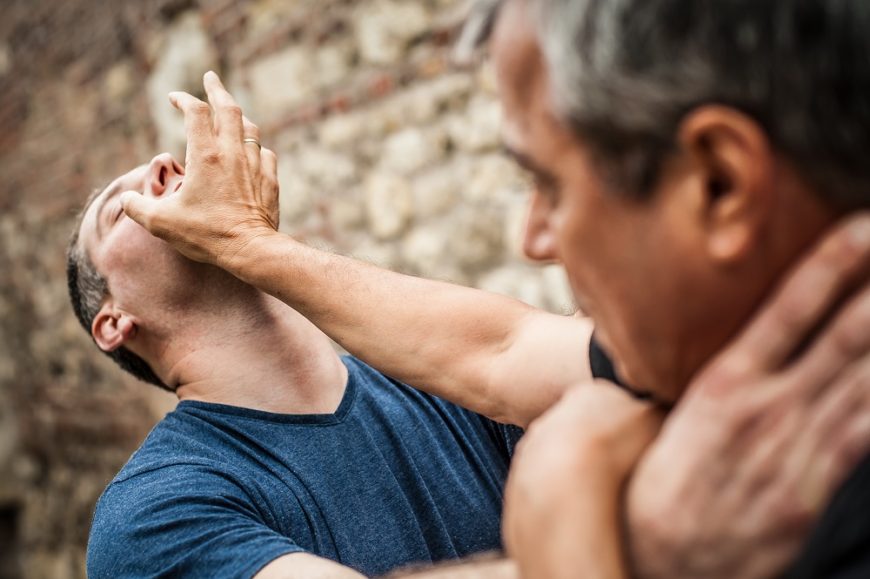Krav Maga vs Jiu Jitsu: What’s Right for You?

Looking to choose between Krav Maga and Jiu Jitsu? This is the guide for you.
In this blog post, we’ll help you decide exactly what martial art to learn by exploring the pros and cons of each.
Topics on this page include:
- Pros and cons of Krav Maga and Brazilian Jiu Jitsu
- How hard is it to learn Krav Maga and BJJ?
- How long does it take to learn Krav Maga vs BJJ
- Key differences between Krav Maga and Jiu Jitsu
Let’s get started:
What is Krav Maga?
Krav Maga is a self-defense system designed specifically for real-world situations.
It was developed for the Israeli Defense Forces by martial artist Imi Licthenfield and is often described as the world’s most complete and effective reality-based self-defense system.
Unlike other martial arts, Krav Maga isn’t typically considered a sport and has no rules.
Instead, it’s easier to think of Krav Maga as a no-holes barred self-defense system purely designed for protecting yourself as effectively as possible.
Due to the lack of rules, Krav Maga uses techniques from several other disciplines, including boxing, wrestling, judo, muay thai, jiu-jitsu, and more.
What is Brazilian Jiu Jitsu?
Not to be confused with Japanese Jiu Jitsu, Brazilian Jiu Jitsu (BJJ) is a self-defense martial art that uses grappling, ground fighting, and submission holds.
It was first developed in 1925 by five Brazilian brothers and focuses on forcing your opponent to submission through chokeholds and joint locks.
The main benefit of Brazilian Jiu Jitsu is to help smaller (and weaker) people defend themselves against much bigger opponents by using leverage and weight distribution to effectively bring them down to the ground.
What Are the Pros and Cons of Krav Maga
Pros of Learning Krav Maga
- In Krav Maga, you’ll regularly take part in realistic training scenarios to prepare you for real-world application.
- It can teach you how to deal with multiple opponents.
- It can teach you how to deal with armed opponents with knives or guns.
- Krav Maga is simple to pick up and has techniques designed to be learned and remembered easily, so it’s accessible to everyone.
- It uses a variety of techniques, including striking and ground work, to give you the best chance of defending yourself in a variety of situations.
- Krav Maga doesn’t just focus on combat but also on how to successfully avoid and defuse situations.
- A great workout for increasing strength and flexibility.
Cons of Learning Krav Maga
- Unlike some martial arts, Krav Maga isn’t built around competitive matches, which might be a downside for those interested in the sports aspect.
What Are the Pros and Cons of Brazilian Jiu Jitsu?
In BJJ, you’ll spend a lot of time practising positions, escapes, and submissions, honing your ability to control and incapacitate an opponent.
Though it may not be as aggressive as Krav Maga, BJJ’s strategic, chess-like approach to combat presents its own unique set of challenges and rewards.
Pros of BJJ
- It can teach you how to take down opponents. As many real fights can end up on the ground, it can be a highly effective self-defense tool.
- BJJ offers a full-body workout to build strength and flexibility.
- It can help teach smaller fighters how to deal with stronger opponents.
- It can provide practical self-defense skills, especially against single attackers.
- Low risk of concussion due to no striking techniques used.
Cons of BJJ
- Not effective against multiple attackers.
- No striking or kicks, which can put you at a disadvantage in many self-defense scenarios.
- Training requires close physical contact, which may not appeal to everyone.
- Can lead to injury if not practised with care, especially during joint locks and chokes.
- You’ll often be training on mats and in a gi (uniform) which won’t prepare you well for real-world situations.
How Hard is Krav Maga to Learn?
Krav Maga is one of the easiest self-defense systems to pick up for beginners.
It uses techniques designed to be learned and remembered easily, so it’s accessible to everyone.
However, like any martial art, it requires dedication and hard work to properly master and improve your self-defense skills.
How Hard is BJJ to Learn?
Brazilian Jiu Jitsu is known as being tough for beginners.
Most classes are focused on sparring, often with more experienced opponents, which can lead to a lot of losses early on.
If you’re an especially competitive person, this early learning curve can be frustrating and has resulted in many practitioners quitting early.
But, like any martial art, if you put the required effort in, you’ll see weekly improvements to your skills.
How Long Does it Take to Learn Krav Maga?
It can take 40 months to master Krav Maga if you train consistently 2-3 times a week.
But this will depend on your fitness levels, training regimen, and how many classes you attend.
For instance, those who attend one class a week will take longer to master Krav Maga than those who attend classes more often.
You can learn more about how long it takes to learn Krav Maga by following the link.
How Long Does it Take to Learn BJJ?
BJJ is one of the longest martial arts in the world to master. In fact, it can take up to 15 years for a Jiu Jitsu practitioner to earn a black belt.
In comparison, martial arts like Karate and Taekwondo can take just 5 years to master.
If you’re looking to master a martial arts quickly, BJJ may not be for you.
Who’s Krav Maga for?
Krav Maga isn’t exclusive to any single demographic.
Whether you’re a complete novice to self-defense or a seasoned martial artist, Krav Maga’s practical approach to self-protection can be a valuable addition to your skill set.
You might find Krav Maga particularly appealing if you:
- Seek effective self-defense techniques that can be used in any situation.
- Prefer a martial art that focuses on fending off multiple attackers and weapon disarming.
- Want a high-intensity workout that also teaches tactical thinking.
Personal security professionals, law enforcement officers, and military personnel often train in Krav Maga due to its emphasis on real-life combat situations, but it’s equally suitable for civilians.
If you desire a no-frills approach to protection and are not particularly drawn to the competitive or traditional aspects of martial arts, Krav Maga might just be the right fit.
Who’s BJJ for?
BJJ is appealing if you’re looking for:
- A martial art with a strong community and competitive scene.
- A way to improve physical fitness alongside learning self-defense.
- Mastery of ground-based defense tactics and submissions.
BJJ is suitable for a wide range of people, from those who enjoy the sporting aspects of martial arts to those committed to self-improvement and self-defense.
Whether you’re a fitness enthusiast or someone searching for a disciplined way to enhance physical and mental well-being, BJJ offers a structured long-term path.
Mastering BJJ can take well over 10 years, so it’s a great hobby to get into if longevity and a constant feeling of progression are important to you.
But due to the lack of striking and kicking techniques, it might not be suited for those looking for a well-rounded approach to self-defense.
Key Differences Between Krav Maga vs BJJ
Striking Versus Grappling: One of the most apparent differences is that Krav Maga incorporates a wide range of striking techniques—punches, kicks, and elbows—alongside defensive moves against weapons. BJJ prioritizes grappling, chokes and joint locks and is known for its ground fighting expertise.
Training Methodology: Krav Maga drills are intense, with scenarios that mimic street confrontations, often involving multiple attackers and high-stress situations. BJJ’s training usually occurs in a more controlled environment, with a focus on sparring (rolling) and technique drilling, aiming at preparing students for competition.
Rules and Restrictions: Krav Maga is designed with the mindset of no rules, as it’s about survival by any means necessary. In contrast, BJJ competitions follow a strict set of rules to ensure the safety of participants. These rules discourage certain dangerous techniques or aggressive behaviour.
Awareness and Adaptability: Practitioners of Krav Maga are taught to be constantly aware of their surroundings and to adapt to rapidly changing situations, a critical skill for self-defense. BJJ fighters might find themselves at a disadvantage in multi-attacker scenarios where ground control methods are less effective.
How to Choose Between Krav Maga vs Jiu Jitsu
Deciding between Krav Maga and Brazilian Jiu Jitsu hinges on your personal goals.
If you’re seeking a martial art that prepares you for real-world self-defense scenarios, Krav Maga’s emphasis on practicality and adaptability might be your best bet.
It’s designed for quick and effective threat neutralization.
But if you’re more interested in a sport-oriented discipline that teaches you how to handle yourself against larger opponents, primarily on the ground, BJJ’s grappling system could be the perfect match.
Remember, your choice should align with what you aim to get out of your martial arts journey—be it fitness, self-defense skills, or the thrill of competition.
Consider your priorities, and you’ll find the path that’s right for you.
Start Now
Krav Maga Induction
An induction is an intro to Krav
Maga with KMI.

